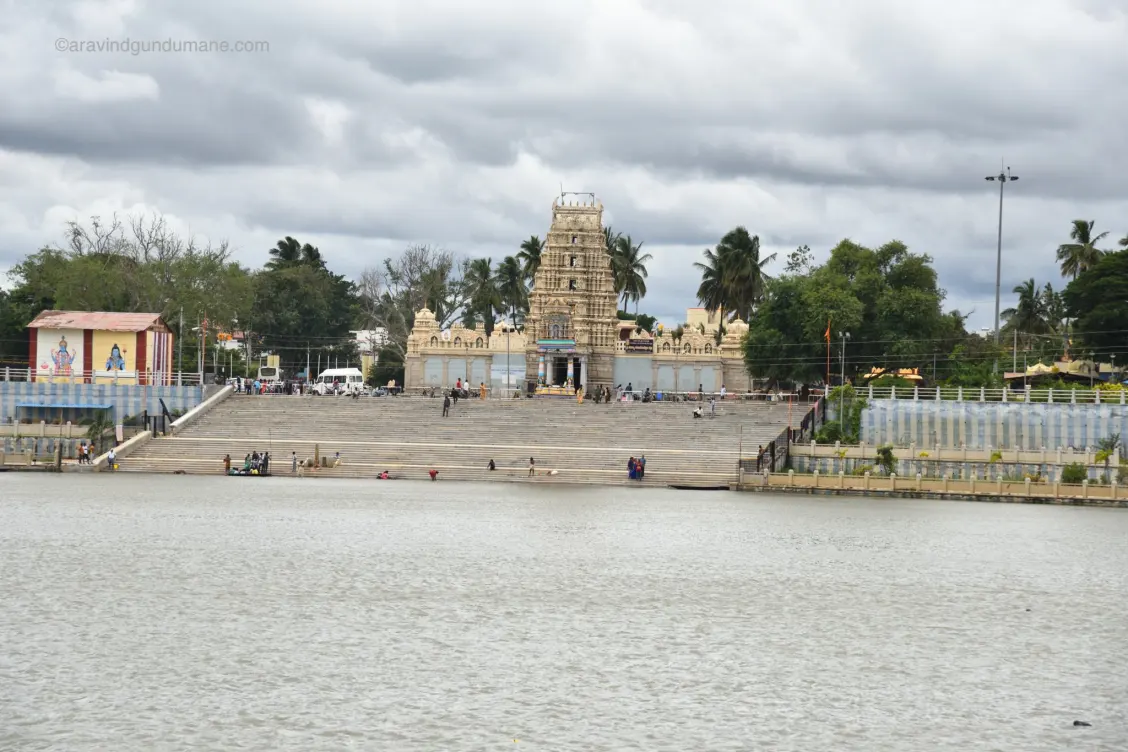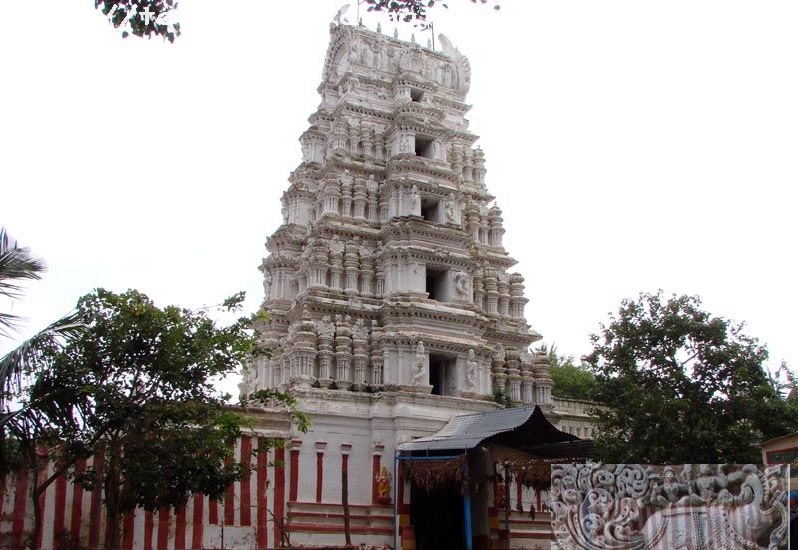T.Narasipura
|
About:
|

T. Narasipura, or Tirumakudalu Narasipura, is a small, historic town located
in the Mysuru district of Karnataka, India. Known for its temples and
spiritual significance, T. Narasipura is considered one of the oldest towns
in Karnataka. It is regarded as a sacred place where the rivers Kaveri,
Kabini, and a mythical river called Spatika Sarovara meet. This holy
confluence, known as a "Triveni Sangama," is a major pilgrimage site and
attracts devotees and visitors interested in the town's rich spiritual and
cultural heritage. The town is home to several temples, with the most
prominent being the Gunja Narasimha Swamy Temple and the Agasthyeshwara
Temple.
|
Location info:
|
| T. Narasipura is situated approximately 30 km southeast of Mysore in Karnataka,
on the banks of the river Kaveri. The town lies in a serene, rural setting,
surrounded by greenery and the confluence of three rivers, creating a peaceful
ambiance.
|
Climate/Weather:
|
| Summer (March-May): Warm with temperatures between 25°C to 35°C.
Monsoon (June-September): Moderate to heavy rainfall, with temperatures between
20°C and 28°C. This season enhances the beauty of the rivers and the surrounding
landscapes.
Winter (October-February): Cool and pleasant, with temperatures ranging from
15°C to 25°C, making it the ideal time to visit.. |
History:
|
| T. Narasipura has a history rooted in Hindu mythology and ancient Indian
civilization. It is believed that sage Agastya visited this town, giving the
Agasthyeshwara Temple its name. The town has been a spiritual center for
centuries, with temples built during various historical periods, especially
during the reigns of the Chola, Hoysala, and Vijayanagara empires. The Gunja
Narasimha Swamy Temple, dedicated to Lord Narasimha, dates back over 500 years
and is one of the most revered temples in the region.
The legend associated with Gunja Narasimhaswamy Temple is that Lord
Narasimhaswamy appeared in the dream of a washerman telling him that his
idol lay beneath the stone on which he washed clothes everyday. The Lord
told him to build a temple for him and asked him to look for gold coins
beneath the stone which could be used for the construction of the temple.
When the washerman expressed his wish to visit (Kashi) Varanasi on a
pilgrimage, the Lord told him that the construction of a temple for Him had
earned him (washerman) an additional punya (blessing) of about a gulaganji
(seed of a twig tree) than that which accrues by visiting Kashi. Thus the
name tak Gunja can me into usage with name of the God Narasimhaswamy
|
Interesting things to do:
|
|
Participate in the Annual Kumbh Mela: T. Narasipura hosts a mini Kumbh Mela,
attracting thousands of devotees who come to take a dip in the Triveni
Sangama.
Ritual Bath in the Triveni Sangama: Devotees believe a dip at the confluence
of the three rivers cleanses them of sins, making it a spiritually uplifting
experience.
Explore the Architecture of the Temples: Marvel at the detailed carvings,
stone pillars, and intricate sculptures in the temples, reflecting different
architectural styles.
Attend Temple Pujas and Aarti: Witnessing the daily rituals and aarti in the
Gunja Narasimha Swamy Temple and Agasthyeshwara Temple is a peaceful and
divine experience.
|
Interesting things to Visit:
|
| Gunja Narasimha Swamy Temple: Dedicated to Lord Narasimha, this ancient temple
features detailed carvings and a beautiful stone structure. It is named after
the Gunja berries offered to the deity.
Agasthyeshwara Temple: Built to honor sage Agastya, this temple houses idols of
various deities and has historical inscriptions dating back centuries.
Triveni Sangama: The sacred confluence of Kaveri, Kabini, and Spatika rivers is
considered one of the town’s main attractions, drawing pilgrims year-round.
Sosale: A nearby village known for its handloom silk weaving, offering visitors
a glimpse into local craft traditions.
Apart from the Gunja Narasimha Swamy temple, there are many other temples
such as the Agasthyeshwara temple. (Sage Agasthya founded and sanctified the
Agasthyeshwara temple.This temple complex contains many monuments belonging
to the Ganga, Chola, Hoysala and Vijayanagara periods at Thirumakudlu, and
also at the Bhiksheswara temple, the Moolasthaneshwara temple and the
Anandeswara temple in the surrounding area.[2]
|
Mobile range info:
|
| Mobile network coverage is generally good in T. Narasipura, with most major
service providers covering the area. However, due to occasional gatherings and
events, there may be some network congestion.
|
How to reach?
|
| Nearest Railway Station: The nearest railway station is Mysore Junction,
about 30 km from T. Narasipura. Mysore is well-connected by train to other major
cities in Karnataka and beyond. |
| Nearest Airport:The nearest airport is Mysore Airport, around 35 km away,
with flights from major cities. Alternatively, Bangalore’s Kempegowda
International Airport is approximately 175 km away. |
| Road Transport: T. Narasipura is well-connected by road from Mysore, with
regular buses and taxis available. It’s a 30-45 minute drive from Mysore. |
Nearest Visiting places:
|
| Mysore: A historic city known for the Mysore Palace, Chamundi Hills, and St.
Philomena’s Church, just 30 km away.
Srirangapatna: Located about 50 km from T. Narasipura, this historic town is
known for Ranganathaswamy Temple and Tipu Sultan’s summer palace.
Nanjangud: About 40 km away, this town is home to the famous Srikanteshwara
Temple, dedicated to Lord Shiva.
Keethinarayana temple, Talakad,Mysore district Profile of a Hoysala temple at
SomanathapuraTalakad an ancient town, situated on the left bank of the river
Kaveri, is 45 km South East of Mysore or 5 km from T.Narsipur. Sri
Kirtinarayana, Sri Kartikeya, Sri Vaideeswara, Sri Pataleswara and Sri
Maraleswara temples are located in this town. Many more monuments lie buried
in the barren expanse of sand dunes in the town.
|
Nearest Petrol Pump:
|
| Petrol pumps are available in T. Narasipura and along the main highway from
Mysore to T. Narasipura, making it easy for travelers to refuel en route.
|
Hotels/Lodge/Accommodation:
|
| Guesthouses and Lodges in T. Narasipura: Budget guesthouses and simple lodges
are available in town for devotees and visitors.
Hotels in Mysore: For more comfortable accommodations, Mysore offers various
options, including budget hotels, mid-range hotels, and luxury hotels.
Home Stays: There are homestay options near T. Narasipura that provide a
traditional, comfortable experience for visitors.
|
Things to carry:
|
| Traditional attire, as it is encouraged within temple premises.
Comfortable footwear suitable for walking around the temple and riverside areas.
Sun protection, including a hat, sunglasses, and sunscreen, especially if visiting during summer.
Water bottle, snacks, and personal essentials, as options may be limited around certain temple areas.
Camera for capturing the scenic and historical sites. |
Tips & Suggestions:
|
| Visit during the winter or the annual Kumbh Mela for the best experience, as the weather is pleasant and the town is vibrant with celebrations.
Respect local customs, especially when visiting temples, by dressing modestly and removing footwear before entering.
Carry extra clothing if planning to take a dip at the Triveni Sangama, as it is a popular ritual for devotees.
Plan ahead and check accommodation availability if visiting during the Kumbh Mela or other festivals, as lodging can be limited.
Avoid littering in temple areas and along the riverbanks to help maintain the sanctity of the place.
|
Help Line/Phone Number:
|
| Police Station:Somanathapura |
| Local Police Station (T. Narasipura):+91-821-223-2375 |




